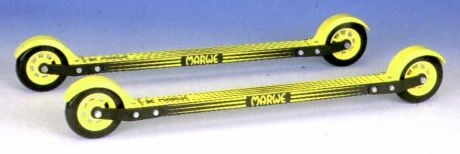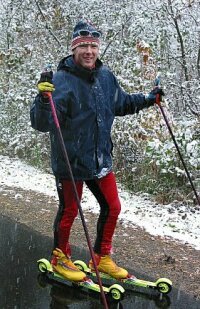News

Products

Field Reports

Stores

Manufacturers
Distributors

Classifieds

|
Field Reports : Marwe
Name: Ben Popp
Report Filed: October 16, 2002
Products used: Marwe 610
When: October 2002
Where: St. Paul, North Oaks
|
|
Winter
in the Midwest can be hit or miss. Realistically, there
are only three months out of the year when there's enough
snow to ski. In the absence of snow, rollerskiing is simply
the best ski-specific training you can do to maintain or
build fitness and improve technique. Oddly enough, most
gear-obsessed skiers don't invest nearly as much time and
research into selecting the right rollerskis as they do
their snow skis. The fact is, the roller ski you choose
is perhaps more important for good form and function than
the snow ski you choose.

Rollerskiing
is a staple of my training program. Unfortunately, over
the years I've made some poor rollerski selections (I should
really listen to my own advice). The result is that I subject
my friends and teammates to a recurring barrage of complaints:
my skis are too stiff; they mush out; they don't track straight;
my feet go to sleep. Currently, I have a pair of alloy shafted
skis with bigger soft wheels that wear out fast and aren't
stable.
My whole
perspective-and continual complaining-changed last week
when I skied on a pair of Marwe's 610 skate skis for the
first time. The difference between my old metal beasts and
the new Marwe's is like night and day. To date, I've logged
about a half-dozen skis on them and I'm sold. Skiing on
the 610's is as close to skiing on snow as you can get out
of a rollerski.
 Marwe's
wheels are stiff and don't mush out when you push off. The
skis track straight as a ruler, making cornering at high
speeds no problem. The big difference between the 610's
and traditional rollerskis, is that they have a wood/fiberglass
shaft. This creates a ski that flexes ever so slightly when
you push off-just like snow skate skis. The wood/fiberglass
shaft also is great for dampening road vibrations-which,
in the past, always put my feet to sleep. The bottom line
is that these are a great pair of skis that I'd highly recommend
to anyone. Marwe's
wheels are stiff and don't mush out when you push off. The
skis track straight as a ruler, making cornering at high
speeds no problem. The big difference between the 610's
and traditional rollerskis, is that they have a wood/fiberglass
shaft. This creates a ski that flexes ever so slightly when
you push off-just like snow skate skis. The wood/fiberglass
shaft also is great for dampening road vibrations-which,
in the past, always put my feet to sleep. The bottom line
is that these are a great pair of skis that I'd highly recommend
to anyone.
Don't
limit your skiing to three months a year. Marwe's 610's
make rollerskiing almost as enjoyable as snow skiing. Find
an old railroad trail, a quiet country road or a paved river
path, and think white. With any luck, you won't be able
to tell the difference.
| Ben
Popp is a member of the SkinnySki.com Race Team and
owner of F.I.T.
Systems training and coaching programs. |
Thanks
to Finn Sisu
for supplying the Marwe 610s. More details on this and
other Marwe products on the Finn
Sisu web site.
|
Name: Margaret Adelsman
Report Filed: May 15, 2001
Products used: Marwe Combis
When: May 2001
Where: Elm Creek, Snail Lake Trails
|
With the snow now off the ground, it never hurts
to keep the memory of on-snow skiing fresh in your legs. I've
had the chance to field test a pair of Marwe Combi rollerskis
that are helping me to do just that.

The Marwe Combi skis come with a front-end extension or
support strut, lengthening each ski by about 8 inches when
in place. The struts, themselves, are very light with a
small, narrow wheel in the front. The wheel doesn't actually
ride the pavement most of the time, until you use the skis
with good back extension in the classical technique. Essentially,
they serve to help keep your ski true when you classical
ski and provide some extra stability. The front wheels contain
ratchets, preventing the skis from back-slipping during
strides. The skis extend about 26" in length without the
support struts, and are about 34" long with them in place.
For classical skiing, I found the skis initially challenging
to use properly. However, this comes from not having rollerskied
classically in quite some time, even though I have had many
years of classical skiing experience on snow. My previous
pair of classic rollerskis was a set of 3-wheeler Exel aluminum-shaft
babies, circa my high school years. Just for fun, I went
back to try those in comparison to the Marwes, and I found
that I could barely stand up on my old Exel rollerskis either.
The take-home lesson was: practice, practice, and practice.
With each subsequent outing on the Combis, I discovered
that I was becoming more and more comfortable using classical
technique. I would begin by doing predominantly double-poling,
finding the balance points of the skis. On gentle climbs,
I began to incorporate kick-double poling until I had achieved
some level of comfort. Finally, I went into the traditional
striding technique, usually on steeper inclines that helped
keep the ski speed relatively low. I discovered during these
outings that it helped tremendously to relax as much as
possible and to focus on the technique that would come naturally
to you on snow. It is always a challenge for me to forget
the hard pavement under rollerskis, and it causes me to
frequently rollerski in a much more timid fashion than I
would on snow. For classical rollerskiing, this actually
doesn't help, because the needed balance of the wheels requires
you to ski without too much sloppiness in your strides.
On snow one usually has the set tracks to help guide your
skis, but the rollerskis actually do you the favor of forcing
you to really focus on your technique and concentrate on
driving your legs in straight strides. Particularly for
full striding technique, I found long, relatively straight
climbs to be very helpful, allowing you to spend a good
length of time working on balance and timing. A good headwind
actually works quite nicely, too.
The great thing about the Marwe Combis resides in the
name Combi: you can use the skis easily for skating as well.
I've found that it is not necessary to remove the front
support struts in order to skate, but it is pretty easy
to take them off and on if you wish. For me, the skis are
quite comfortable for skating, although some people may
find them a little slow, compared to the Marwe 610's for
example. I like this, however, given my generally timid
approach to rollerskiiing. I found that I could maneuver
comfortably down most hills without feeling out of control.
I also think this is very helpful in keeping the ski speed
down, allowing you to work on classical technique without
spending your entire workout double-poling. The wheel diameter
(about 1.5") is also a little wider than the Marwe 610's,
providing a bit slower, but very stable ride. I found the
skis to be very forgiving for cracks and general road debris,
including small areas of sand, gravel and sticks. I usually
err on the side of caution, not wanting to take a tumble,
but I felt that the wheels were slipping much less than
what I was used to on my old rollerskis (both classical
and skating).
Although I have not yet incorporated rollerskiing as a
major part of my training routine for this time of the year,
I have really enjoyed getting out to some of the area parks
to reconnect mentally with the snow season. For me, classical
skiing does this even more so than skating, and I think
spending some time developing the comfort level necessary
to use the Marwe Combis for classical as well as skating
is really time well spent in helping to prepare for a successful
snow ski season. While classical rollerskiing is arguable
a little more challenging to learn than skating, I think
the Marwe Combis provide an excellent tool for both skilled
and more novice classical skiers to practice their technique
during the off-season.
Thanks to Finn
Sisu for supplying us with the Marwe Combis. More
details on this and other Marwe products on the Finn
Sisu web site.
|
|
|



